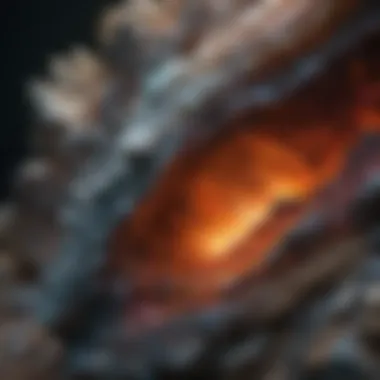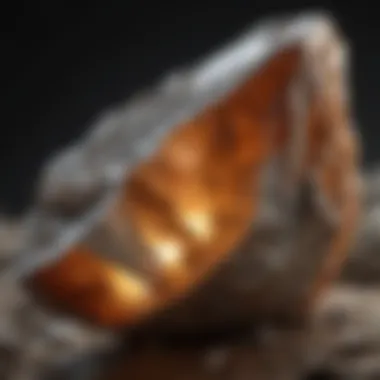Unveiling the Spectacular World of Mica: A Geological Marvel Explained


Rock and Fossil Identification
Mica, a mesmerizing mineral boasting intricate crystalline structures, holds a prominent place in the geological realm. When it comes to identifying mica rocks, it's crucial to understand the various types and their unique characteristics. Muscovite, biotite, and phlogopite are among the common types of mica, each distinguished by specific properties such as color, transparency, and cleavage patterns. To accurately identify mica specimens, collectors should familiarize themselves with these distinguishing features.
Geological Insights
Delving deeper into the geological significance of mica unveils a world of fascinating formations and processes. Mica deposits are often found in igneous and metamorphic rocks, offering vital insights into the Earth's history and composition. Understanding the geological context of mica can provide valuable information about ancient environments, geological processes, and even past climate conditions. Moreover, notable discoveries in mica research continue to shed light on the intricate connections between geology and the natural world.
Introduction
Mica, a natural wonder encapsulated within the Earth's crust, is a mineral that intrigues the curious minds of geologists and admirers of geological splendor. This introductory section sets the stage for a deep dive into the captivating realm of mica, unveiling its mesmerizing properties, diverse applications, and profound geological significance.
Defining Mica
Composition and Characteristics
Mica's composition and characteristics epitomize its allure in the geological sphere. Comprised of silicate minerals known for their layered structure, mica boasts exceptional flexibility, thermal stability, and electrical resistance. These attributes render mica a preferred choice in various industries, from electronics to construction. However, the unique feature that sets mica apart lies in its remarkable cleavage properties, allowing it to be easily split into thin, transparent sheets, unveiling its inner luminosity.
Geological Formation
The geological formation of mica unveils a fascinating tale of metamorphic processes, where intense heat and pressure transform existing rock minerals into the radiant beauty we recognize as mica. Its formation within schist or granite showcases nature's intricate craftsmanship and the enduring impact of geological forces. One significant advantage of mica's geological formation is its association with pegmatites, mineral-rich pockets that bear an abundance of mica crystals, offering insight into ancient geological events and mineralogical evolution.
Types of Mica
Exploring the diverse types of mica sheds light on its richness and variety within the Earth's tapestry. Muscovite, biotite, and phlogopite stand as prominent members of the mica family, each possessing distinct properties and applications. Muscovite, prized for its transparency and resilience, finds its place in electrical insulation and decorative arts. Biotite's dark allure makes it sought after in cosmetic pigments and construction materials. Phlogopite, with its unique thermal properties, contributes notably to the industrial sector and high-temperature applications. Understanding the distinctive features of each mica type is essential to appreciating the mineral's versatility and prevalence across varied fields.


Historical Significance
Early Uses
From ancient civilizations to modern industries, mica's early uses trace a path of continual fascination and practicality. Early communities utilized mica for cave paintings, ritual adornments, and insulation purposes, recognizing its natural resilience and aesthetically pleasing properties. Over time, mica evolved to serve as a vital component in industrial processes, including early electrical inventions and innovative constructions. The enduring appeal of mica lies in its historical relevance as a symbol of durability, adaptability, and aesthetic charm.
Cultural References
Mica's cultural references weave a tapestry of symbolism, artistry, and tradition across diverse societies. Whether revered as a protective talisman or esteemed in artistic endeavors, mica's shimmering presence in folklore and artistry transcends time and borders. Its reflective qualities symbolize enlightenment and spiritual awakening in various cultural contexts, adding a layer of mystical allure to its mineralogical splendor. An exploration of mica's cultural significance unveils the intricacies of human connection with the Earth's treasures, bridging the past with the present in a timeless narrative.
The Marvelous Properties of Mica
In the exploration of the captivating mineral mica, understanding its properties is crucial to grasping its significance in the geological world. Mica boasts a range of remarkable characteristics that make it a unique substance worth examining closely in this article. From its intricate crystalline structure to its versatile applications, mica stands as a testament to the wonders of natural formations on Earth.
Physical Attributes
Transparency and Color:
Transparency and color are key aspects that define mica's physical attributes and play a vital role in its overall appeal. The transparency of mica allows light to penetrate, creating a visually striking effect that showcases its layered structure. The range of colors found in mica, including vibrant hues such as gold, green, and silver, adds to its aesthetic beauty. This interplay of transparency and color not only enhances the visual appeal of mica but also serves as a crucial factor in determining its quality and value within the context of this article.
Lustre and Cleavage:
The lustre of mica, characterized by its reflective quality and ability to shine when exposed to light, elevates its visual allure. This unique property gives mica a distinct sheen that sets it apart from other minerals, making it a popular choice in various applications. Additionally, mica's cleavage - the way it breaks along flat planes due to its layered structure - contributes to its versatility. The ease of cleavage allows mica to be split into thin sheets, making it a valuable material for uses ranging from insulation to artistic creations. Understanding the lustre and cleavage of mica is essential in appreciating its significance within the scope of this article.
Chemical Composition


Silicate Structure:
The silicate structure of mica is a pivotal aspect that influences its properties and applications. Mica is primarily composed of silica, which forms a stable framework responsible for its resilience and thermal resistance. This unique structure grants mica its characteristic flexibility and durability, making it a sought-after material in various industries. The silicate arrangement in mica not only contributes to its strength but also enhances its natural beauty, underscoring its importance in the narrative presented in this article.
Trace Elements:
In addition to its silicate composition, mica may contain trace elements that further enhance its properties. These elements, such as iron, magnesium, and potassium, impart specific characteristics to mica, providing a rich diversity of textures and colors. The presence of trace elements adds depth to mica's chemical composition, influencing its physical attributes and expanding its potential applications. Understanding the role of trace elements in mica is imperative for comprehensively exploring its geological marvel within the context of this article.
Applications of Mica
In this comprehensive exploration of the world of mica, the section dedicated to applications of mica plays a crucial role in shedding light on the practical uses and significance of this versatile mineral. Mica, with its intricate crystalline structure and diverse properties, finds itself indispensable in various industries and artistic endeavors. This section will delve into the importance of mica applications in showcasing the mineral's adaptability and contribution to different fields.
Industrial Uses
Insulation
Unveiling the exceptional properties of mica in insulation applications highlights its crucial role in numerous industries. The ability of mica to resist high temperatures and electrical conductivity makes it a preferred choice for insulation purposes. This subsection highlights the exceptional thermal and electrical insulating properties of mica, elucidating why it is a popular and beneficial choice for insulation in this article. Moreover, the unique feature of mica insulation lies in its resilience to extreme conditions, offering unparalleled advantages and few disadvantages in serving the insulation needs in various settings. Additionally, its stability and reliability in insulating electrical equipment make it an indispensable material.
Electronics
The utilization of mica in electronics underscores its significance in enhancing electronic devices and components. Its crucial role in facilitating thermal management and electrical insulation in electronics makes it a valuable material in this realm. This subsection emphasizes the key characteristic of mica in electronics, explaining why it is a preferred and beneficial choice within the scope of this article. Furthermore, the unique feature of mica in electronics lies in its ability to improve heat dissipation and prevent electrical disturbances, offering distinct advantages with minimal drawbacks within the context of electronic applications. Its precision as a dielectric material highlights its importance in ensuring the reliability and longevity of electronic products.
Geological Significance
In this meticulously crafted article unraveling the captivating world of mica, the section on Geological Significance stands as a pivotal exploration of the role this mineral plays in the vast landscape of geology. The geological significance of mica lies in its abundance and widespread distribution across various geological settings, making it an integral part of geological formations and processes. By delving into the geological significance of mica, we can gain valuable insights into the earth's intricate history and the forces that have shaped our planet over millions of years.


Occurrence in Nature
Associated Minerals
Associated Minerals are key companions to mica and play a fundamental role in its formation and geological context. These minerals, such as quartz, feldspar, and amphibole, interact with mica during the metamorphic processes, influencing its properties and distribution. Their presence alongside mica in rock formations adds diversity and complexity to the mineral assemblages, contributing to the uniqueness of mica-bearing rocks. The combination of mica with Associated Minerals enhances its utility in petrological studies and provides valuable clues about the geological environments in which mica crystallized.
Formation Processes
Formation Processes elucidate the pathways through which mica comes into existence, shedding light on the geological conditions that foster its growth. Mica forms through metamorphic transformations of pre-existing minerals under specific temperature and pressure regimes, a process known as metamorphism. The interplay of heat, pressure, and mineral reactions govern the formation of mica-rich rocks, offering a glimpse into the dynamic nature of the earth's crust. Understanding the intricate Formation Processes of mica provides a window into the deep geological processes that shape the earth's crust and contribute to the diversity of rock types we observe today.
Impact on Rock Formations
Metamorphic Environments
Metamorphic Environments play a crucial role in dictating the characteristics and distribution of mica within rocks. These environments, where intense heat and pressure transform existing rocks into new forms, offer the ideal conditions for mica to crystallize and grow. The presence of mica in metamorphic rocks serves as a marker of the specific metamorphic conditions prevailing during their formation, providing geological clues about the depth and temperature histories of rocks. By studying mica in different Metamorphic Environments, geologists can unravel the complex tectonic processes that have shaped mountain belts and continental crusts over geological time scales.
Structural Contributions
Structural Contributions of mica in rock formations are multifaceted, with mica crystals often aligning themselves parallel to the direction of pressure during metamorphism. This preferred orientation imparts a characteristic foliation to rocks containing mica, known as schistosity, offering crucial insights into the deformational history of rocks. Moreover, the presence of mica in structural zones influences the mechanical properties of rocks, creating geotechnical challenges in civil engineering projects. By analyzing the Structural Contributions of mica, geologists can decipher the deformational events that have molded the earth's crust and understand the complexities of mountain-building processes.
Environmental Considerations
Environmental considerations play a pivotal role in understanding the impact and importance of mica on the natural world. By delving into the environmental factors related to mica extraction and usage, we gain insight into how human activities can influence ecosystems. Environmental considerations in this article focus on examining the ecological effects of mica, shedding light on both its advantages and potential consequences. The interplay between mica mining processes and ecological systems underscores the need for sustainable practices that minimize environmental harm while harnessing the valuable properties of this geological marvel.
Ecological Effects
Extraction Practices
Extraction practices constitute a critical aspect of mica's ecological footprint. The methodical removal of mica from the earth's crust involves extensive mining operations that can lead to habitat disruption and soil erosion. Understanding the key characteristics of extraction practices is essential for evaluating their environmental impact. One primary facet is the use of heavy machinery, which often contributes to deforestation and alters local landscapes. Despite their efficiency in extracting mica, these practices can have detrimental effects on surrounding flora and fauna. Balancing the demand for mica with sustainable extraction methods is crucial for preserving biodiversity and ecosystem stability.
Environmental Regulations
Environmental regulations serve as crucial safeguards in mitigating the ecological consequences of mica mining and usage. These regulations govern the permissible limits on waste disposal, water usage, and air emissions associated with mica processing. Highlighting the key characteristics of environmental regulations reveals their role in promoting responsible mica extraction practices. By enforcing compliance with environmental standards, regulators ensure that mica industries operate in an environmentally conscious manner. The unique feature of environmental regulations lies in their ability to strike a balance between economic interests and environmental protection, fostering a sustainable approach to mica utilization.







